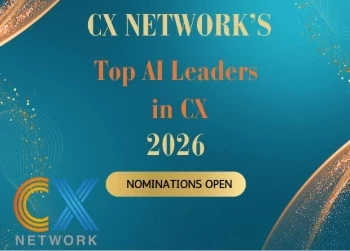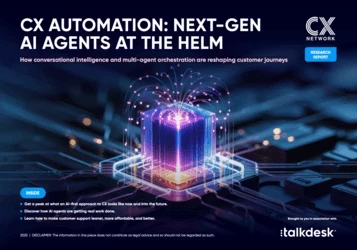Keep CX management human in the age of AI
Keeping CX management human means ensuring it strengthens emotional intelligence and human connection
Add bookmark
Will people remain at the center of customer experience (CX) even in the age of artificial intelligence (AI)? More than 40 percent of organizations use AI-powered co-pilots for customer service 60 percent have implemented them for IT help desks, according to Nvidia. By all accounts, the number is growing as AI advances and becomes more human-like. Respondents to the survey for the 2024 Global State of CX Report said AI technologies for operations was among the most impactful trends of the year, second only to data and analytics.
Don't miss any news, updates or insider tips from CX Network by getting them delivered to your inbox. Sign up to our newsletter and join our community of experts. 
Indeed, AI is a powerful tool that promises speed, scale and personalization that has never been realized previously. However, as chatbots answer questions and algorithms predict needs, a critical question emerges: Are brands losing the human touch that makes CX magical?
The biggest risk of implementing AI
Customers, thought leaders and practitioners have expressed their concerns. Jane Hawkes, a CX thought leader and writer of the Lady Janey blog, recently told UK companies that they risk "losing customers if they replace humans with chatbots."
"It is no surprise to me whatsoever that AI responses lead to poorer outcomes and results and this means UK brands are at risk of losing out on potential revenue if they go along with a trend rather than understand what their potential customers want," said Hawkes, according to Yahoo! Finance.
As AI revolutionizes customer experience, leaders must ensure technology enhances, rather than replaces, the emotional intelligence and human connection that customers crave. People are at the center of CX and that must not change, even in the age of AI.
In fact, survey after survey has shown that customers want to talk to other people. More than 90 percent of US consumers prefer human agents for customer interactions, according to a recent Kinstra survey. A Five9 survey found that 75 percent prefer talking to a real human in person or over the phone for customer support. Nearly half of consumers said they do not trust information provided by AI-powered customer service bots.
"AI has the power to mitigate customer service frustrations, but it's the human touch that makes the difference," says Niki Hall, chief marketing officer at Five9. "By using AI to automate transactional and routine tasks, human agents can free up time to focus on more complex issues that require critical thinking and sensitivity."
The ramifications of going all in on technology at the expense of humanity are real. "When companies focus solely on automation without fostering human connection, they risk losing the essence of their customer experiences," writes Jennifer Lee, chief operating officer at Intradiem, in Forbes. "Customers don't just notice this shift; they feel it. When a company deprioritizes the human element in customer interactions, it can result in declining customer satisfaction, brand erosion and long-term loss of loyalty and revenue."
Steps to keeping humans at the center of CX
In its 2025 CX trends report, Zendesk suggested that "human-centric AI is redefining customer loyalty," but what does that look like? In ComputerWeekly.com, Lianne Dehaye wrote about the 5 Cs of customer expectations: consistency, convenience, competence, customization and continuity. The call to action is meant to drive people back to the basics of CX.
"When used appropriately in alignment with these 5Cs, AI has the potential to revolutionize customer engagement," she wrote. "However, processing vast amounts of customer data with AI can also lead to misuse, causing serious repercussions for businesses, including ethical and legal issues, operational inefficiencies or damage to reputation. The most powerful AI isn't the one that solves the most complex problems but the one that solves the right problems. Instead of asking, 'What can AI do?' perhaps organizations should ask, 'What should AI do?'"
CX influencer Shep Hyken recently wrote about the book AI Mindshift: Unleash the Power of AI, Avoid the Pitfalls and Keep the Human Experience (Prime Concepts Group Press, 2024) by Ford Saeks. He shared takeaways, one of which will resonate because everyone is trying to provide more efficient service and many see AI as a solution for speed.
"Your customers want answers now, not later. AI can deliver immediate first responses through chatbots, but here's the key - make sure your customers can seamlessly transition to a human agent when needed," Hyken writes in his summary of the book. "I refer to this as the Time to Happiness - how quickly you can move a customer from frustrated to satisfied. The faster, the better."
This falls in line with Lee's suggestion to apply AI to enhance the work of human agents in customer service. Another important step that most experts agree on is being choosy about which tasks to automate. Getting real-time customer insights, using sentiment analysis to understand when to escalate an issue to a human agent and automating manual, repetitive tasks are the best ways to empower the humans, wrote Lee.
One of her best pieces of advice was to measure the AI applications by more than efficiency. She reminds CX professionals that they must also consider quality. Therefore, she advises people to consult data points from CX metrics like customer satisfaction (CSAT) and net promoter score (NPS).
Some might think that avoiding AI all together is the answer to keeping humans relevant. But that's a mistake, too. Those who don't understand how to use this precious new tool will be left behind, warns Saeks in his book. In addition, he reminds readers that the human element is irreplaceable and the value of AI depends on the people applying it.
"Adopting AI isn't about using the newest tools or keeping up with trends," Saeks writes. "It's about making smarter decisions faster. It's about blending human insight with machine intelligence to unlock opportunities that were impossible just a few years ago."
Quick links:
- How to ask the best customer survey questions
- 3 Customer service trends to follow for better brand reputation
- 9 Customer journey mapping tools




















